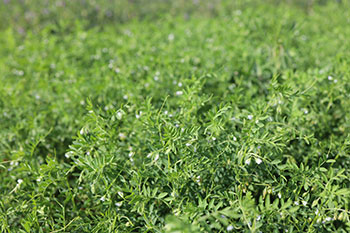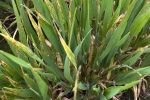Overcoming agronomic constraints will accelerate the development of a WA lentils industry
‘Best bet’ agronomy packages, including herbicide use, are being developed to support the ongoing development of a high-value pulse industry, including lentils, in Western Australia.
In 2019, GRDC invested in a three-year project with the WA Department of Primary Industries and Regional Development (DPIRD) to run 34 small-plot pulse experiments throughout WA’s wheatbelt.
The lentil trials were concentrated in the Esperance Port Zone, where most of WA’s lentil production is centred.
A key aim of the lentil trials was to highlight new varieties and their agronomy. This included herbicide tolerance traits and new chemistries that are working their way to market.
 Lentil on a trial site in Mallee, NSW. Photo: Sophie Clayton
Lentil on a trial site in Mallee, NSW. Photo: Sophie Clayton
Lentils were found to be particularly sensitive to soil-applied herbicides in Mallee soils. In general, less damage was observed when herbicides were applied before sowing compared with post-sowing/pre-emergent.
The safest option was the combination of imidazolinone (IMI) herbicides and IMI-tolerant varieties. However, IMI herbicides have not been widely used by Esperance lentil growers due to residue concerns, as rotations do not include many IMI-tolerant canola or cereals. Additionally, there are concerns about developing resistant weeds, especially wild radish.
That leaves Esperance growers preferring conventional lentil varieties and choosing to use low rates of triazine herbicides and/or Group 14 herbicides such as Reflex® and Terrain®, which are a better fit than IMI herbicides for these farming systems.
Lines reputed to be metribuzin tolerant – which have shown good results in eastern Australia – were found to be more sensitive when grown on WA’s lighter Mallee soils.
Similarly, the sodic subsoil with elevated boron levels creates issues in lentils in the Esperance region, with PBA Bolt the most popular variety due to its tolerance to these soil constraints.
While a project aim was to increase lentil production to 40,000 hectares by 2024, lentil production peaked in 2019 at 16,000ha.
That dry year highlighted key constraints facing lentils on WA Mallee soils, particularly a need for greater adaptation to WA soils and conditions and a need for improved herbicide tolerance.
Both issues are being addressed through GRDC investment in an expanded National Lentil Breeding Program (see GroundCoverTM Supplement story Lentil breeding on turbocharge) and support for the ‘Acid Tolerance Screening’ project.
Table 1: Seed yield (t/ha) of selected lentil lines in DPIRD time-of-sowing experiments at Grass Patch (2020 and 2021) and Ridley (2022).
| Year | Sowing date | CIPAL1701 | PBA Bolt | PBA Hallmark XT |
|---|---|---|---|---|
| 2020 |
28 April 12 May 2 June |
2.0 2.9 3.1 |
1.7 2.1 2.8 |
0.8 1.8 2.8 |
| 2021 |
1 April 15 April 14 May 8 June |
2.3 2.0 2.0 1.8 |
1.7 1.9 2.2 1.8 |
1.4 1.9 2.0 1.7 |
| 2022 |
12 April 2 May 18 May 31 May |
1.8 1.9 2.2 2.4 |
0.8 1.4 1.9 2.3 |
1.2 1.3 2.0 2.1 |
Source: DPIRD
Sowing time
Growers in the Esperance region often sow lentils in mid-to-late April to fit with their canola and cereal programs. Lentils grow well when sown early, but growers have asked whether April is the best time to sow lentils. As part of the GRDC-invested project, DPIRD conducted a series of time-of-sowing experiments to address this.
Sowing in mid-May to early June produced the best yields. However, the project team was able to identify a line, CIPAL1701, from the National Breeding Program that maintained high yields at early sowings.
CIPAL1701 is a conventional non-IMI-tolerant variety with similar characteristics to PBA Bolt in terms of tolerance to salt and boron and produces similar-sized seed.
In 2022, ratings indicated CIPAL1701 had much better Botrytis grey mould resistance then PBA Bolt.
Consequently, in 2023, the project team bulked up CIPAL1701 as a potential release for Esperance growers who grow PBA Bolt. CIPAL1701 is now being multiplied by Seednet.
There has been keen interest and high demand for CIPAL1701 seed in the Esperance region, with the majority of lentil growers keen to have a variety that fits in with their existing PBA Bolt seed type while offering improved sowing time flexibility.
Future prospects
The success of lentils in South Australia has led growers in the western region to consider their potential, particularly in the Esperance Port Zone where the environment is similar. At present, the area sown mirrors the early phase of lentil expansion in the southern region.
Recent experience by early adopters has shown that new lentil varieties sown in April can yield 1.5 to two tonnes per hectare at on-farm grain prices above $425/t (the 10-year average is $650/t), making them much more attractive than field peas (1.5t/ha and $300/t).
Some growers have also indicated interest in replacing canola with lentils.
Assessment of land capability combined with economic analysis puts the potential production area for lentils in WA at 40,000ha. However, this could increase to between 100,000 and 200,000ha – a value of about $200 million a year – with the successful development of herbicide-tolerant and acid-tolerant varieties.
Extension and resources
Over the project’s three years, 74 field day talks were given to more than 4300 people, in addition to presentations at GRDC Research Updates, DPIRD industry days, grower group meetings, consultant training days and specialist workshops.
All of the experiments conducted by the project team are available on the GRDC Online Farm Trials website. The information will continue to be used in extension activities to develop the WA pulse industry.
More information: Mark Seymour, mark.seymour@dpird.wa.gov.au
Resources: read GroundCover Supplement stories Extending high value pulses to WA and Overcoming acid soils.

























































